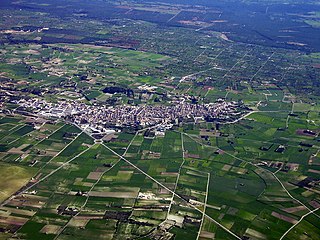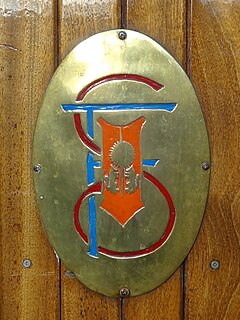
Mallorca, or Majorca, is the largest island in the Balearic Islands, which are part of Spain and located in the Mediterranean.

Rail transport in Spain operates on four rail gauges and services are operated by a variety of private and public operators. The total route length in 2012 was 16,026 km.

Ferrocarrils de la Generalitat de Catalunya, or FGC, is a railway company which operates several unconnected lines in Catalonia, Spain.

The Ferrocarril de Sóller, acronym FS, is an interurban railway and the name for the company which operates the electrified 3 ft narrow gauge tracks running between the towns of Sóller and Palma on the Spanish island of Mallorca.

Serveis Ferroviaris de Mallorca or SFM is a company which operates the metre gauge railway network on the Spanish island of Majorca. The total length, including Palma Metro, also operated by this company, is 85 km.

Bunyola is a municipality of the island of Mallorca, Spain, located in the spurs of the Serra de Tramuntana, at a distance of 9 miles (14 km) from Palma. The municipality has an area of 32.67 square miles (84.6 km2) and a population of 6,636 inhabitants,INE Instituto Nacional Estadística and the Ferrocarril de Sóller passes through it on the way to Palma..

Binissalem is a small municipality in the district of Raiguer on Majorca, one of the Balearic Islands, Spain, and the centre of the island's wine region of Binissalem DOP.

Artà is one of the 53 independent municipalities on the Spanish Balearic island of Majorca. The small town of the same name is the administrative seat of this municipality in the region (Comarca) of Llevant.

Santa Margalida is a municipality with a population of 10,204 located in the northeast of the Spanish Balearic Island Majorca.

Sant Llorenç des Cardassar is a small municipality on Mallorca, one of the Balearic Islands, Spain.

The Palma Metro is a light metro system in Palma, Majorca, Spain. The initial line of the system, M1, is 7.2 kilometres (4.5 mi) long and has nine stations. It was constructed between 2005 and 2007 at cost of 312 million euros and opened for service on 25 April 2007. In March 2013, an existing 8.35-kilometre (5.2 mi) rail line with nine stations was incorporated into metro system as the M2 line.
The Divisiones Regionales de Fútbol in the Balearic Islands, are organized by Balearic Football Federation :
A Natural Area of Special Interest is a protected area within the Balearic Islands, Spain that is below the level of a natural park.

Palma Intermodal Station is the main railway station of Palma on the island of Majorca, Spain. It is located at the Plaça d'Espanya in the centre of the city and is also known as Palma Plaça d'Espanya.

UIB is a station on the Palma Metro. It is situated on the south side of the main campus of University of the Balearic Islands, which is located in northern part of Palma on the island of Majorca, Spain.

The Tranvía de Sóller is a Spanish heritage tramway serving the town of Sóller and the coastal village of Port de Sóller, in the island of Majorca. It is owned by Ferrocarril de Sóller S.A. (FS), the same company operating the heritage rail line linking the town to the city of Palma.

In Spain there is an extensive 1,250 km (780 mi) system of 1,000 mmmetre gauge railways. The majority of these railways was historically operated by FEVE,. Created in 1965 FEVE started absorbing numerous private-owned narrow-gauge railways. From 1978 onwards, with the introduction of regionalisation devolution under the new Spanish constitution, FEVE began transferring responsibility for a number of its operations to the new regional governments. On 31 December 2012 the company disappeared due to the merger of the narrow-gauge network FEVE and the broad-gauge network RENFE.
Traditionally, the gauge of the national railway in Spain, now managed by Adif, is 1,668 mm, known as Iberian gauge. This gauge was decided upon by a Parliamentary committee, after a report known as the Informe Subercase in 1844. Spain has 11,791 km of track with this gauge.
Jaume Bauzà Coll is a Spanish retired footballer who played as a midfielder, and is a manager.



















